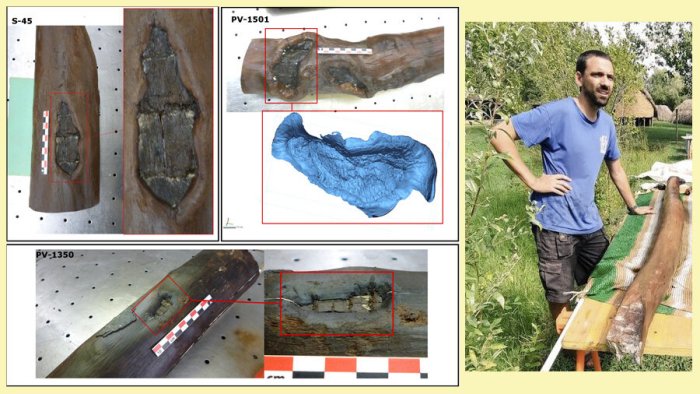Jan Bartek – AncientPages.com – Researchers have identified marks carved intentionally on bay trees some five or ten years before the Neolithic settlement of La Draga was built in Banyoles 7,200 years ago. The discovery confirms the presence of human groups in the area before they settled there, showing they selected, marked and controlled the forests.

General and detailed image of the anthropic marks identified on bay tree posts at La Draga. Right: Oriol López-Bultó at La Draga, with an oak post recovered from the site. Credit: Autonomous University of Barcelona
A research team from the Universitat Autònoma de Barcelona (UAB) has found the earliest known evidence of forest management based on the analysis of several of these anthropic markings located on posts made out of bay tree wood (Laurus nobilis) used in building La Draga (Banyoles, Girona), the only lakeside Neolithic site of the Iberian Peninsula dating back 7,200 to 6,700 years.
The research was conducted by Oriol López-Bultó, Ingrid Bertin and Raquel Piqué, from the UAB Department of Prehistory, and archaeologist Patrick Gᴀssmann, and was published in the International Journal of Wood Culture after being presented at the From Forests to Heritage conference held in Amsterdam, the Netherlands in 2022.
The study indicates that the trees were marked several times with adzes. The wood continued to grow on top of the scars left by the marks, and some five to ten years later, those same trees were cut down and converted into posts to be used in the early phases of building the settlement.
Marks such as the ones found at La Draga had been previously identified at a site located in Switzerland, the Hauterive-Champréveyres site, but were at least 1,000 years younger than the ones found at La Draga.
“The discovery is of great importance due to the extreme difficulty in finding archaeological evidence on when and how the first groups of humans managed these forests, given the natural degradation of the wood over time,” points out Oriol López-Bultó, first author of the article.
La Draga is one of the few European sites to register wooden remains in good conditions, due to being submerged in water on the edges of Lake Banyoles.
“There are signs that the communities at La Draga managed the forests, but until now we have not been able to demonstrate this with enough physical evidence,” explains Raquel Piqué, co-authora of the research. “The results allow us also to confirm the presence in the area of a group of people inhabiting La Draga years before the settlement was established and who selected, marked and controlled the forest.”
Wood rarely used in the Neolithic
Bay tree wood was rarely used in the Neolithic in Europe, despite it being readily available in areas mainly located close to lakes. In the case of La Draga, it is documented in the remains of fires, tools, and in very few elements used for building, with a very secondary role when compared to oak: of the 1,200 posts recovered to date from the site, bay tree wood represents only 1.4%, in comparison to the 96.6% of posts made out of oak.
The marks of forest management at La Draga however were only discovered on bay tree posts, opening the question of why this type of wood was intentionally marked. “It could have been a way to avoid the use of this wood, for practical reasons, such as marking different territories, or even for symbolical reasons, but more studies will be needed clarify this question,” researchers point out.
Profound knowledge of natural resources
Researchers confirmed in earlier studies that the inhabitants of La Draga had a profound knowledge of the natural resources surrounding the settlement. They managed plants and animal herds and used oak for practically everything, with an accurate selection of shapes and dimensions when building the posts that would later be used to build their cabins.
“The management of forests is a very relevant economic and social activity, which requires expertise, planification and social organization to succeed. Once again, our study demonstrates the economic importance and evolution of the inhabitants of La Draga and, in general, of the Neolithic groups of the western Mediterranean,” states López-Bultó.
To conduct the study, researchers used a combination of different methodologies, such as direct observation and registration, traceology and experimental archaeology, 3D scanning, taxonomic identification and dendrochronology.
A lakeside site unique in Spain
The archaeological site of La Draga, discovered in 1990, lies on the eastern shore of Lake Banyoles and is one of the earliest farming and livestock rearing settlements in the northeastern part of the Iberian Peninsula, as well as one of the first lakeside Neolithic sites to exist in Europe (5200–4800 BCE). While it was inhabited, the settlement formed the shape of a peninsula inserting itself into the lake, with a soft and continuous downward slope. Based on the prospecting work, it is estimated that the settlement measured some 8,000 square meters.
The location of the site, in permanent contact with the water level, has contributed to the exceptional conservation of the organic materials, from wooden posts used for the cabins to tools (ax handles, sickles, digging sticks, etc.), remains of woven baskets and even rope. These remains make La Draga one of the most important sites in which to study Europe’s Neolithic era.
The study was published in International Journal of Wood Culture
Written by Jan Bartek – AncientPages.com Staff Writer





